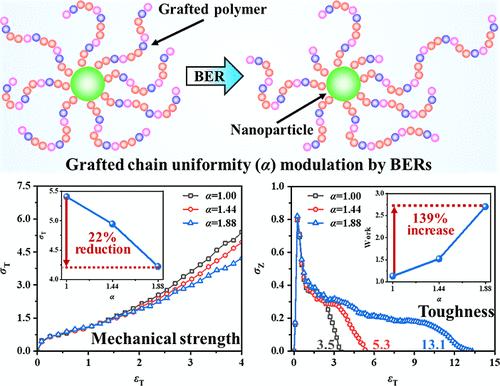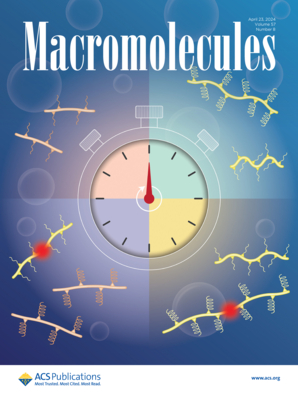由键交换驱动的无基质聚合物接枝纳米粒子的拓扑设计与机械操控
IF 5.2
1区 化学
Q1 POLYMER SCIENCE
引用次数: 0
摘要
通过键交换反应(BERs)定制机械性能需要精确的拓扑操作,但将结构和性能与复杂的拓扑结构准确关联起来仍是一项挑战。本研究深入研究了具有动态共价键的无基质聚合物接枝纳米粒子(PGNPs),并探讨了拓扑控制如何调节材料特性。通过粗粒度分子动力学模拟,研究了由接枝聚合物终端引发的误码分解所引起的接枝聚合物均匀性(α)的变化。提出了创新的 α 动力学理论模型,以捕捉拓扑结构的时间演化,并阐明 BER 动力学和初始拓扑结构的重要影响。此外,α 平衡理论模型还描述了平衡拓扑结构,揭示了接枝聚合物的几何分布。这些理论模型进一步扩展到终端触发的误码率以外的情况,从而肯定了它们的全面适用性。随后,研究阐明了特定拓扑结构如何显著提高韧性,并揭示了其内在机制,从而构建了结构-性能关系。总之,这项研究不仅解决了 PGNPs 拓扑表征中的实验难题,还强调了战略性拓扑设计在确定材料特性和推动材料科学发展方面的重要性。本文章由计算机程序翻译,如有差异,请以英文原文为准。

Topological Design and Mechanical Manipulation of Matrix-Free Polymer Grafted Nanoparticles Driven by Bond Exchanging
Tailoring mechanical properties through bond exchange reactions (BERs) demands precise topological manipulation, yet accurately correlating structures and properties to complex topologies remains a challenge. This investigation delves into matrix-free polymer grafted nanoparticles (PGNPs) with dynamic covalent bonds and examines how topological control can modulate material properties. Through coarse–grained molecular dynamics simulations, the alterations in the grafted polymer uniformity (α) induced by BERs triggered by terminals of grafted polymers are examined. Innovative α-kinetics theoretical model is proposed to capture the temporal evolution of topologies and elucidate the significant influence of BER kinetics and initial topology. Additionally, the α-equilibrium theoretical model characterizes equilibrium topologies, revealing the geometric distribution of grafted polymers. The theoretical models are further extended to include scenarios beyond terminal-triggered BERs, affirming their comprehensive applicability. Subsequently, it is elucidated how specific topological configurations can significantly enhance toughness and reveal the intrinsic mechanisms, which enable the construction of structure–property relationships. In summary, this study not only addresses the experimental challenges in the topological characterization of PGNPs, but also underscores the importance of strategic topological design in determining material properties and advancing material science.
求助全文
通过发布文献求助,成功后即可免费获取论文全文。
去求助
来源期刊

Macromolecules
工程技术-高分子科学
CiteScore
9.30
自引率
16.40%
发文量
942
审稿时长
2 months
期刊介绍:
Macromolecules publishes original, fundamental, and impactful research on all aspects of polymer science. Topics of interest include synthesis (e.g., controlled polymerizations, polymerization catalysis, post polymerization modification, new monomer structures and polymer architectures, and polymerization mechanisms/kinetics analysis); phase behavior, thermodynamics, dynamic, and ordering/disordering phenomena (e.g., self-assembly, gelation, crystallization, solution/melt/solid-state characteristics); structure and properties (e.g., mechanical and rheological properties, surface/interfacial characteristics, electronic and transport properties); new state of the art characterization (e.g., spectroscopy, scattering, microscopy, rheology), simulation (e.g., Monte Carlo, molecular dynamics, multi-scale/coarse-grained modeling), and theoretical methods. Renewable/sustainable polymers, polymer networks, responsive polymers, electro-, magneto- and opto-active macromolecules, inorganic polymers, charge-transporting polymers (ion-containing, semiconducting, and conducting), nanostructured polymers, and polymer composites are also of interest. Typical papers published in Macromolecules showcase important and innovative concepts, experimental methods/observations, and theoretical/computational approaches that demonstrate a fundamental advance in the understanding of polymers.
 求助内容:
求助内容: 应助结果提醒方式:
应助结果提醒方式:


